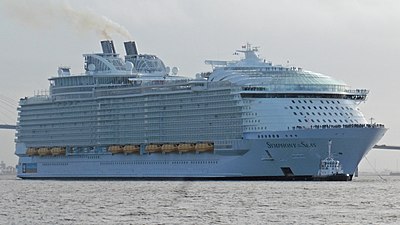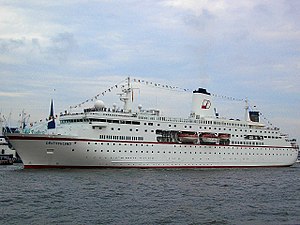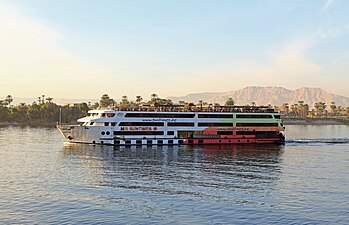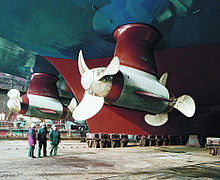Cruise ship

A cruise ship is a passenger ship whose task is not the transport service from one port to another, but the journey ( cruise ) itself. As a rule, several interesting tourist destinations in a region or a sea area are approached according to plan within a certain period of time.
Classification
First and foremost, cruise ships can be divided into ocean and river cruise ships based on their area of application. In 2008 there were a total of 310 ships with a capacity of 370,000 beds available to those interested in ocean cruises worldwide.
There are different ways to categorize cruise lines. Ocean cruise ships in particular can specialize in a certain type of cruise, such as luxury cruises, classic comfort cruises or contemporary cruises (see cruise types ). Breakdowns by size, business model or lifestyle are common. Depending on the interests, character, age and financial situation of the travelers, the focus is on luxury, adventure, education and culture, entertainment, fitness , wellness , relaxation or special topics. The size, equipment and crew is adapted to the respective target group.
Cruise ships can also be classified by assigning stars. In principle, each shipping company can award its own stars to its ships, but this is hardly ever used; rather, most shipping companies adopt the judgment of the renowned British ship appraiser Douglas Ward , who annually publishes his assessments from practical tests in a book: Berlitz Complete Guide to Cruising & Cruise Ships (mockingly "Kreuzlinerbibel").
Ocean cruise ship: the Ruby Princess for a crew of 1200 and up to 3030 travelers
River cruise ship:
Katharina von Bora
requirement
Before a cruise ship can carry passengers, it must be approved by one of the global classification societies. The certificate obtained according to SOLAS certifies the ship's seaworthiness and the safety of the passengers.
history


The invention of the cruise is attributed to the Peninsular and Oriental Steam Navigation Company (P&O). This company started as a shipping route between Britain and the Iberian Peninsula ( English Iberian Peninsula ). In 1840 it started the postal service to Alexandria. From 1844 it offered luxury cruises to Gibraltar, Malta and Athens. P&O Cruises are the oldest cruise company in Europe.
The German shipowner Albert Ballin , General Director of Hamburg-based Hapag, is considered to be the pioneer in using the free winter capacities of the shipping lines for cruises . Since the transatlantic passages were booked significantly less in winter due to the bad weather and the choppy sea, Ballin sent the Augusta Victoria in 1891 on a test basis for an “educational and pleasure trip” to the Mediterranean . This trip was a success through and through - the ship was fully booked and the "cruise" was born. This form of sea voyage quickly became popular, with many shipping companies offering additional cruises in their programs.
In the second half of the 20th century, demand changed completely from the passage (crossing) to the cruise: the development of the commercial aircraft increased the proportion of long-haul air traffic; Shipping companies lost accordingly in the passenger business and increasingly concentrated on cruises and discovered other sources of income such as the shore leave with organized excursions. Up to the end of the 1990s / beginning of the 2000s, a large number of cruise ships that had been built as passenger ships were still in use. Examples of this are the former French flagship France , later Norway , the Queen Elizabeth 2 or the Rotterdam . Occasionally sailing ships have also been converted for this purpose, such as the Sea Cloud or newly built, such as the Royal Clipper .
As of the end of 2018, there were 317 cruise ships worldwide with a total capacity of 537,000 passengers. Compared to 2011 with around 19 million passengers on cruise ships, the number of passengers carried rose to around 26 million in 2018.
As of June 2019, 124 cruise ships with an order volume of more than 69 billion dollars were in the planning stage.
The expedition cruise ship Fram of the Hurtigruten ASA shipping company
Germany was the last German ocean cruise ship and was flagged out on the flag of convenience of the Bahamas in 2015
River cruise ship on the Nile (Egypt)
Situation in recent times
In the meantime, large passenger ships are mostly only built as cruise ships, such as the Symphony of the Seas , currently the largest cruise ship, or as ferries . Classic "liners" (the ships of the line of the merchant navy ) are only used in market niches . One example is the Queen Mary 2 of the British Cunard Line , which offers seasonal liner services between New York and Southampton in addition to cruises. This still pays off even today, as numerous passengers who are afraid of flying book these trips. The ships of the specialized shipping companies are largely similar to one another and differ mainly in whether they were built for the medium or high-price segment, which is reflected in the cabin size and number, the number of dining rooms and seats in casinos and the frequency of passenger changes at special terminals . Most of the new buildings with their numerous standard cabins are deliberately designed for a medium-sized mass audience, the few large luxury suites are more of a subsidy business, but important for building the image of the ship.
So-called expedition cruise ships are a specialty. These ships, which are usually specially equipped, have a higher ice class if they are used in polar or sub-polar regions . The Fram is a modern expedition ship . The Bremen is operated by a German shipowner. The Polar Star is a converted icebreaker that is used by the Norwegian shipping company Hurtigruten ASA in the polar regions.
The list of cruise ships contains a sortable selection of cruise ships.
The concentration of providers of cruises regionally or on all oceans can be read off with the help of the list of shipping companies of cruise ships .
In 2019 there were around 5,000 passenger ships, including 500 cruise ships. There are also around 800 river cruise ships worldwide.
The Deutschland was the last cruise ship to operate under the German flag. It was sold after the bankruptcy of the Peter Deilmann shipping company and in 2015 it was flagged out on the flag of convenience of the Bahamas .
A trend towards larger sizes can be seen in the new ships. Two thirds of the new ships have space for more than 2000 passengers and thus belong to the mega-ships category. The preliminary climax of this development was the Symphony of the Seas with a gross tonnage of 228,081 and space for 6,870 passengers, which entered service on March 31, 2018 as the largest cruise ship to date.
These so-called mega-ships are increasingly becoming the actual travel destination (with parks, shopping centers, ice rinks, etc.) and are in no way inferior to staying on land due to the many innovative facilities and leisure opportunities. Megaships pose difficult and expensive logistical problems for many of the traditional ports and places of call; for example with the provision of the extra-long pier, with bus, restaurant and shopping capacities, etc. For example, on the popular one-week Caribbean cruises from Florida, only three large ports can be called instead of five to eight ports. Above all, the general wellness and health trend is reflected in the construction of new ships. A variety of modern treatments, restaurants for the health-conscious and minor cosmetic procedures are offered on board.
Personnel on board
There are different categories of crew on cruise ships. This includes officers, crew and personnel, with larger ships there are also intermediate levels. Officers are employees with special responsibility and decision-making powers who work in the nautical, technical or hotel sectors. They work for 3 - 6 months and are well to very well paid. The largest part of the crew is the crew who also work in the three areas. Personnel include all employees who work either through external companies (concessionaires) or in shops, beauty / hair salons and casinos on board. The numerical ratio of staff to guests is around 1 to 3, on luxury ships often even 1 to 1.5. Over 2000 people work on the largest cruise ships. The service staff is called a steward or stewardess. As in any company, the behavior of employees with direct customer contact is of particular importance.
Cruise ships are tightly organized and operate under the flag of an international secondary register or so-called favoring country such as Panama , the Bahamas or Liberia . These countries have weaker occupational safety laws , so that the team in particular via external companies in the hotel sector has correspondingly few rights on board. Crew members have fixed-term employment contracts with a contract duration of up to twelve months. The shifts often last up to 12 hours a day, seven days a week. The recreational opportunities on board for the crew members are limited to the staff room. Only senior employees, such as officers, are allowed to use parts of the public passenger areas.
The following flags are used (Oct. 2018) by the International Transport Workers Federation ITF as flags of convenience:
-
 Antigua and Barbuda
Antigua and Barbuda
-
 Equatorial Guinea
Equatorial Guinea
-
 Bahamas
Bahamas
-
 Barbados
Barbados
-
 Belize
Belize
-
 Bermuda
Bermuda
-
 Bolivia (landlocked country)
Bolivia (landlocked country) -
 Germany (international second register)
Germany (international second register) -
 Faroe Islands
Faroe Islands
-
 France (international second register)
France (international second register) -
 Georgia
Georgia
-
 Gibraltar
Gibraltar
-
 Honduras
Honduras
-
 Jamaica
Jamaica
-
 Cayman Islands
Cayman Islands
-
 Cambodia
Cambodia
-
 Comoros
Comoros
-
 Lebanon
Lebanon
-
 Liberia
Liberia
-
 Madeira
Madeira
-
 Malta
Malta
-
 Marshall Islands
Marshall Islands
-
 Mauritius
Mauritius
-
 Moldova (landlocked country)
Moldova (landlocked country) -
 Mongolia (landlocked country)
Mongolia (landlocked country) -
 Myanmar
Myanmar
-
 Netherlands Antilles
Netherlands Antilles
-
 North Korea
North Korea
-
 Panama (currently the second largest merchant fleet)
Panama (currently the second largest merchant fleet) -
 St. Vincent and the Grenadines
St. Vincent and the Grenadines
-
 Sao Tome and Principe
Sao Tome and Principe
-
 Sri Lanka
Sri Lanka
-
 Tonga
Tonga
-
 Vanuatu
Vanuatu
-
 Cyprus
Cyprus
technology
The vast majority of cruise ships have a diesel-electric drive and have stabilizing fins to dampen rolling movements.
Ship networks
Modern technology is particularly important on large cruise ships. With the development of digital technologies and the Internet , the demands on cruise ships with regard to network equipment also increased. This not only affects the comfort of the passengers (internet access, etc.), but also the drive and monitoring technology and the communication between the crew and the rest of the world. For this reason, modern cruise ships are equipped with powerful and fail-safe computer networks. Since the operating conditions for cabling on ships are often very rough (vibration and heat in the engine rooms, etc.), the same products are often used as in the field of industrial data cabling ( Industrial Ethernet ).
Emissions
Marine diesel engines run on heavy fuel oil , which is a waste product from the petroleum refinery and has long had a high sulfur content. The resulting environmental impacts have been and are controversially discussed. Some modern cruise ships are powered by liquefied natural gas (LNG) instead of heavy fuel oil . According to a study by NABU , of 76 cruise ships examined in 2019, with the exception of the AIDAnova , all ran on heavy fuel oil. Only the Costa Smeralda , which was under construction at the time and , like the AIDANova, belongs to the Helios class , is also operated with liquefied natural gas.
All shipping and aviation account for around three percent of global emissions of the greenhouse gas CO₂. Calculated per passenger, a ship emits less carbon dioxide than a car. However, the concentration of carbon dioxide, nitrogen oxides and fine dust on board cruise ships and in ports is well above the limit values that apply to road traffic. Measurements on the AIDAsol showed a peak of 475,000 ultrafine particles per cubic centimeter of ambient air, and thus a concentration that many times exceed the peak values of around 30,000 particles per cm³ in German road traffic, which are also above the statutory limit values . A half-hour measurement on the AIDAprima recorded an average of 68,000 particles per cubic centimeter. At the peak, the concentration was 500,000 particles. AIDA Cruises rejected the reviews. The measurements lacked any scientific basis and did not constitute a recognized test method.
Even while the ships are in port, they continue to supply themselves with energy from the ship's diesel engines, which produces sulfur dioxide, carbon dioxide, nitrogen oxides, soot and fine dust. This is also environmentally relevant for inner-city ports with neighboring offices and apartments. It was therefore proposed to set up shore power connections so that the ships can draw their electrical energy from them and switch off the engines. Since there are still no uniform connections and standards for current strength and voltage for the supply of shore power for the various types of ship, no uniform solution has yet been found in Europe.
Progress has been made around the world on pollution with sulfur dioxide. From 2010, a limit value of 3.5% sulfur content applied to heavy fuel oil, and 1% in sulfur-controlled zones. Since January 1, 2020, ships worldwide have only been allowed to use low-sulfur fuel. This marine fuel may only contain 0.5 percent sulfur. On the North and Baltic Seas, in German ports and many coastal areas, a limit of 0.1 percent has been in force for some time.
In July 2017, NABU addressed the fact that cruise ship operators were reluctant to switch to cleaner fuels or efficient exhaust gas cleaning processes. The Cruise Lines International Association criticized the statements of the NABU as "undifferentiated consideration", which led to "false conclusions and misunderstandings", as well as non-standardized investigations. The British TV broadcaster Channel 4 reported that there were pollutant concentrations from exhaust gas on the deck of the ships, like in heavily polluted Asian cities. Norway plans to ban ships with poor emissions from entering the popular fjords and from draining sewage.
In 2019, a study by Transport and Environment was published which shows that Carnival's cruise ships alone emitted almost ten times more sulfur oxides along Europe's coasts in 2017 than all 260+ million passenger vehicles in Europe combined.
Shipyards
There are currently four shipyards or shipyard groups that build large cruise ships.
The Fincantieri - Cantieri Navali Italiani SpA, headquartered in Trieste is the largest European shipbuilding company and builds cruise ships at its shipyard facilities in Monfalcone, Marghera (Venice) and Sestri Ponente (Genoa). In 2018, the Italian group Fincantieri took over 50% of the shares in STX France. The company was then renamed Chantiers de l'Atlantique . The shipyard is located in Saint-Nazaire, France, at the mouth of the Loire and the Atlantic.
The Meyer shipyard in Papenburg is a German shipbuilding company that is best known for its large shipyard in Papenburg (Emsland district). Meyer Werft has been 100 percent owner of Meyer Turku shipyard since April 2015 and owns the Neptun shipyard in Rostock, where river cruise ships and engine room modules are built.
MV Werften is the name of a new shipyard group that operates three shipyards in Mecklenburg-Western Pomerania. It belongs to the Genting Hong Kong company (Genting HK). The company has had cruise ships built at the three traditional shipyard locations Wismar, Rostock and Stralsund since 2017. Lloyd Werft Bremerhaven also belongs to Genting Hong Kong .
Mitsubishi Heavy Industries in Japan (Nagasaki) was briefly involved in cruise ship construction and got off again after an expensive failure (2 ships of the Hyperion class for AIDA Cruises ).
See also
literature
- Andreas Stirn: dream ships of socialism. The history of the GDR vacation ships 1953–1990 . 2nd Edition. Metropol Verlag, Berlin 2011, ISBN 978-3-940938-79-4
- Cruise shipping is changing . In: Schiff & Hafen , issue 12/2009, pp. 22–25. Seehafen-Verlag, Hamburg, ISSN 0938-1643
- Douglas Ward: Complete Guide to Cruising & Cruise Ships 2006 . Polyglott, 2005, ISBN 3-493-60252-9 , 672 pp.
- Oskar Levander: Clever & clean, the little crusader . In: Deutsche Seeschifffahrt , Issue 2/2012, pp. 52–57, Association of German Shipowners, Hamburg 2012, ISSN 0948-9002
Web links
- Klaus Ahrens: Billionaire's yacht “Sea Cloud”. Lady between servants . Spiegel Online - Reise, September 25, 2006 (Compares with similar ships)
Individual evidence
- ^ Axel Schulz: Modes of transport in tourism: air traffic, rail traffic, road traffic, ship traffic . Oldenbourg, Munich 2008, ISBN 978-3-486-58876-7
- ↑ Capacity | Cruise Market Watch. Retrieved August 20, 2019 (American English).
- ^ Cruise Market Watch: Cruise Market Watch Announces 2011 Cruise Line Market Share and Revenue Projections | Cruise Market Watch. Retrieved August 20, 2019 (American English).
- ↑ Capacity | Cruise Market Watch. Retrieved August 20, 2019 (American English).
- ↑ SPIEGEL ONLINE: Cruises: Air pollution, exploitation, crowds - the madness. Retrieved August 20, 2019 .
- ↑ Frank Binder: Trend towards luxury liners with many beds . In: Daily port report of October 17, 2013, p. 15
- ^ Douglas Ward: Berlitz Complete Guide to Cruising & Cruise Ships 2009: Expert advice that saves you money. In-depth reviews of 280 cruise ships. Reveals the best facilities, food, service . 18th edition, Polyglott, 2008, ISBN 978-3-493-60255-5
- ↑ Flags of convenience at ITF Global
- ^ [1] , Developments in Propulsion, accessed on February 16, 2020
- ↑ Which holidays are particularly bad for the environment . In: Tages-Anzeiger , December 22, 2008
- ↑ Unsustainable for climate, environment and health. nabu.de
- ↑ Cruises: Air pollution, exploitation, crowds - it's madness. Spiegel Online, accessed August 20, 2019 . (Paywall)
- ↑ Antje Blinda: Cruise Ship Ranking of the Nature Conservation Union: Which ship is least harmful to the environment? Spiegel-Online, August 21, 2019, accessed on August 21, 2019 .
- ↑ Environmentally sinner cruise ship: Thick air on the sun deck. Stern, May 2, 2017, accessed September 2, 2018 .
- ↑ Dirk Asendorpf: How high is the consumption of a cruise ship? Zeit-Online, August 31, 2017, accessed September 2, 2018 .
- ↑ Antje Blinda: Cruise ship: ARD magazine measures high emissions on “Aida Prima”. Spiegel-Online, March 9, 2017, accessed September 2, 2018 .
- ↑ ARD-Magazin: Emissions levels on “Aida Prima” are as high as on a busy street. Kölner Stadt-Anzeiger, March 9, 2017, accessed on September 2, 2018 .
- ↑ How many cruise ships come per year and what emissions are associated with them? ( Memento from January 23, 2013 in the Internet Archive ), HafenCity Hamburg.
- ↑ IMO again sets milestones for climate protection in maritime shipping - roadmap for worldwide CO2 regulation and stricter emissions values adopted. Association of German Shipowners date = 2016-10-18, accessed on February 14, 2020 .
- ↑ CLIA statement on the NABU cruise ranking. CLIA Germany, accessed June 3, 2018 .
- ^ Thick air on the sun deck: comparison with Shanghai and New Delhi. ORF-News, July 5, 2017, accessed on July 5, 2017 .
- ↑ One corporation to pollute them all. European Federation for Transport and Environment AISBL, June 4, 2019, accessed on June 16, 2019 (English).
- ↑ Massive exhaust emissions in ports from cruise ships. Naturschutzbund Deutschland , June 5, 2019, accessed on June 16, 2019 .









